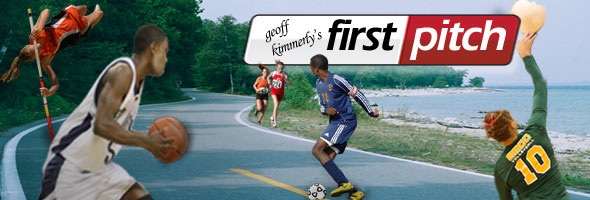
Things change; lessons are the same
February 29, 2012
Let's start with the obvious: High school sports have evolved a bit since 1927.
But the MHSAA Bulletin from March of that year -- dug up by one of our directors on another research pursuit -- reminds us how some of our challenges remain the same.
Below are a few excerpts from the section titled "Baseball and Sportsmanship." Keep in mind, baseball was the football and basketball of the first half of the 1900s. The 1927 New York Yankees arguably were the greatest baseball team of all-time, finishing 110-44 thanks to Babe Ruth, Lou Gehrig and others.
Those names alone make us think in a historical context -- which makes the parallel between today and the following that much more intriguing:
Baseball games furnish a difficult problem to schools in the matter of sportsmanship, spectator control and their education.
Many more people are familiar with the game of baseball and its rules than is true of either football or basketball. Consequently, they feel even more qualified to criticize.
In many places, absence of seating facilities bring the spectators into close proximity to players with the result that criticism of players and of the official and sometimes abusive remarks to the visiting team can occur. No school can hope to improve this situation by ignoring it.
The MHSAA Bulletin went on to cite suggestions for improvement that had been published by the Delaware association. Again, a sampling:
Treat the visiting team as guests, not as deadly enemies. Small youngsters often offend through ignorance. Educate them along this line.
Fair and impartial applause of good plays by either side should be encouraged in the student body, and the outside fans will soon fall in line.
"Razzing" or "riding" visiting players is poor sportsmanship.
Caution your boys to pay no attention to the "grandstand experts" who feel it their duty to offer suggestions as to the work of the team. They can sometimes do more harm in an hour than can be overcome in days of practice.
And a final note from the 1927 MHSAA on the subject:
An athletic contest properly staged and handled creates a favorable impression on the part of visitors toward your school and community. A game that deteriorates into a backyard squabble hurts not only the school and its executives, but the town as well.

2025 Scholar-Athlete Award Recipients Announced in Class C & D
By
Geoff Kimmerly
MHSAA.com senior editor
February 4, 2025
The Michigan High School Athletic Association has selected 10 student-athletes from Class C and D member schools to receive scholarships through the MHSAA/Farm Bureau Insurance Scholar-Athlete Award program.
 Farm Bureau Insurance, in its 36th year of sponsoring the award, will give $2,000 college scholarships to 32 individuals who represent their member schools in at least one sport in which the Association sponsors a postseason tournament. The first 30 scholarships are awarded proportionately by school classification and the number of student-athletes involved in those classes; also, there are two at-large honorees who can come from any classification.
Farm Bureau Insurance, in its 36th year of sponsoring the award, will give $2,000 college scholarships to 32 individuals who represent their member schools in at least one sport in which the Association sponsors a postseason tournament. The first 30 scholarships are awarded proportionately by school classification and the number of student-athletes involved in those classes; also, there are two at-large honorees who can come from any classification.
Students applying for the Scholar-Athlete Award must be carrying at least a 3.5 (on a 4.0 scale) grade-point average and have previously won a letter in a varsity sport in which the Michigan High School Athletic Association sponsors a postseason tournament. Other requirements for the applicants were to show active participation in other school and community activities and produce an essay on the importance of sportsmanship in educational athletics.
The 32 scholarship recipients will be recognized March 15 during the MHSAA Boys Basketball Finals at the Breslin Student Events Center in East Lansing.
The Class C Scholar-Athlete Award honorees are Dayne Behning, Munising; Kelcie Pung, Fowler; Isaiah Kabban, Harbor Beach; Trevor Nolan, Munising; and Wheatley Rodammer, Saginaw Valley Lutheran.
The Class D Scholar-Athlete Award recipients are Sarah Bradley, Clarkston Everest Collegiate; Ella Knudsen, Leland; Joshua Gaunt, Dollar Bay; and Dakota Malek, Fulton.
Overviews of the scholarship recipients of the Class C Scholar-Athlete Award follow. A quote from each recipient's essay also is included:
 Dayne Behning, Munising
Dayne Behning, Munising
Played four seasons of varsity tennis and three of varsity volleyball, is playing her fourth of varsity basketball and will compete in her fourth of track & field this spring. Earned all-state in cross country, all-Upper Peninsula recognition in tennis and all-conference in volleyball and basketball; and earned academic all-state team and individual honors in cross country. Served as team captain of tennis and volleyball varsities. Serving in second year on student council with leadership roles as council vice president and also class vice president. Participating in fourth year of Key Club and as vice president. Participating in second year of National Honor Society, third in Youth in Government, third on yearbook staff and competing in first year of quiz bowl. Is considering attending Baker College to study veterinary technology.
Essay Quote: “The reality of high school athletics in the Upper Peninsula often means long bus rides and hours of travel for away games. This distance creates a unique dynamic among athletes, especially when you spend years competing against the same opponents. Over time, the girls on opposing teams become familiar faces – people you’ve grown up playing with. Through countless games and practices, rivalries evolve, and competition becomes a shared language. We end up being each other's biggest cheerleaders.”
 Kelcie Pung, Fowler
Kelcie Pung, Fowler
Ran four years of varsity cross country, will compete in fourth season of track & field this spring and played varsity basketball as a sophomore and junior. Earned all-state in both cross country and track, the latter all of her first three seasons, and helped track team to Lower Peninsula Division 4 Finals championship last spring. Served as cross country team captain this past fall. Serving fourth year on school’s student athletic advisory council, and as president, and also serving as student council class secretary. Participating in fourth year with school’s LINKS program and serving as president for second year. Participating in third year of National Honor Society and fourth with school’s renaissance program for students with strong academics. Will attend Saginaw Valley State University and study upper elementary education.
Essay Quote: “Sportsmanship can be seen in the moments where adversity is overwhelming and where the outcome is far from expectation. In the depths of a difficult situation, there is a choice to make. The decision between sportsmanship or dwelling on defeat define one’s character. Just like other personal values, genuine sportsmanship is contagious and does not go unnoticed.”
 Isaiah Kabban, Harbor Beach
Isaiah Kabban, Harbor Beach
Played two seasons of varsity football and will compete in fourth of track & field this spring; also played junior varsity basketball two seasons. Earned all-area in football and helped team to league and District championships. Earned all-state in powerlifting and twice qualified for state meet. Earned academic all-league in football and track. Served as football and track throws captain and coached middle school flag football and as varsity basketball student assistant. Will complete second associate degree before high school graduation. Serving on MHSAA Student Advisory Council and participated in student government throughout high school including as vice president. Served as representative for local district’s Congressional Youth Council. Serving as national director of ongoing legislation for American Youth Association and was a national spokesperson finalist for the National Rural Electric Cooperative Association’s Youth Leadership Council. Participated in American Legion Boys State and Boys Nation with leadership roles. Is undecided on which college he will attend, but intends to study public policy.
Essay Quote: “Sports only matter because we agree they do – and because of the relentless work we put into them. … (Sportsmanship is) what makes the game more than just a competition. It’s the foundation that gives sports their meaning, their stories, and their legacy.”
 Trevor Nolan, Munising
Trevor Nolan, Munising
Ran four years of varsity cross country, is playing his fourth of season of varsity basketball and will compete in fourth of track & field this spring; also played varsity football for the first time this past fall. Helped basketball team to 2023 Division 4 Finals championship and has earned all-state and academic all-state recognition in that sport. Won multiple league championships in cross country and earned all-Upper Peninsula honors, and was Finals relay champion in track. Earned all-conference honorable mention in football. Served as cross country and basketball team captain. Participating in second years of National Honor Society and Key Club and served on student council as a freshman as class president. Is undecided on which college he will attend, but intends to study physical therapy or kinesiology.
Essay Quote: “A coach once told me that the reason why high school sports are so successful is that they are great at teaching young kids how to mature into adults. There is no better way to teach kids how to develop great character than by teaching them the importance of sportsmanship. … Growing up, I was not always a good sport, but as I got older I learned the importance of sportsmanship through many important lessons.”
 Wheatley Rodammer, Saginaw Valley Lutheran
Wheatley Rodammer, Saginaw Valley Lutheran
Played four seasons of varsity soccer, is playing his second of varsity basketball and will compete in his fourth of track & field this spring. Earned all-league and all-District in soccer and contributed to academic all-state team. Qualified for MHSAA Track & Field Finals as part of relay. Served as captain of soccer and basketball teams. Participated two years in National Honor Society, four years in school’s Protect Life group and in STEM and Global Awareness clubs as a junior. Will serve as head timer for grade school track meets for fourth year this spring and head announcer for third year. Completed Great Lakes Area Leadership Camp. Will attend Saginaw Valley State University and study a business-related major.
Essay Quote: “Throughout my years in grade school and high school sports, I have often heard coaches repeat phrases like “practice makes perfect” and “you get out of it what you put into it.” These lessons have prepared me for life beyond sports. Having good sportsmanship is a personal choice that requires commitment. There is a significant difference between showing sportsmanship only when it feels convenient and displaying it consistently, no matter the circumstances. Educational athletics often throw curveballs your way, requiring you to remain composed and prepared at all times – not just when you feel like it.”
Other Class C girls finalists for the Scholar-Athlete Award were Baylee Goddard, Alcona; Kaylee Kranz, Clinton; Alexyn DuBois, Hanover-Horton; Grace Hayhurst, Harbor Springs; Allie Nowak, Johannesburg-Lewiston; Kate Mattson, Munising; Ashlyn Orr, New Lothrop; Tess Tillman, Royal Oak Shrine Catholic; and Makayla Zelinko, St Charles.
Other Class C boys finalists for the Scholar-Athlete Award were Lucas Hall, Bark River-Harris; Owen Heath, Bridgman; Jason Zarate, Brighton Charyl Stockwell Prep; Matthew Mellendorf, Cass City; Korbyn Russell, East Jordan; Carson Kienitz, Munising; Ian Weldon, Reese; Ben Denlinger, Roscommon; and Landon Pestrue, St Louis.
Overviews of the scholarship recipients of the Class D Scholar-Athlete Award follow. A quote from each recipient's essay also is included:
 Sarah Bradley, Clarkston Everest Collegiate
Sarah Bradley, Clarkston Everest Collegiate
Played four seasons of varsity volleyball, playing fourth of varsity basketball and also played varsity softball as a sophomore. Led volleyball team to Division 4 championships the last two seasons, making the all-state first team after both and earning honorable mention as a sophomore. Helped basketball team to District titles her first three seasons, earning all-state as a junior and academic all-state in that sport as well. Served as volleyball team captain three seasons and basketball her final two. Earned AP Scholar recognition and is ranked first in her graduating class with a 4.3 weighted grade-point average. Serving second year on student government, as vice president, and participating in second year of National Honor Society. Served as ECyD youth group team leader throughout high school and two years as yearbook senior editor. Will attend Calvin University and study nursing.
Essay Quote: “To truly have this pivotal quality, it is necessary to not only be a good winner but also a good loser. It is easy to congratulate the other team on playing well when the outcome is in your favor. However, it is much harder to look into the eyes of your opponent who just ended your season and tell them they played well.”
 Ella Knudsen, Leland
Ella Knudsen, Leland
Played four years of varsity golf and ran four seasons of cross country, is playing her third of varsity basketball and will compete in her fourth season of track & field this spring; also played varsity soccer as a freshman and sophomore. Earned all-state three times in cross country, once in track and all-conference in basketball, and earned academic all-state in those three sports and golf. Served as captain of cross country, basketball and track teams. Earned AP Scholar recognition and Rural and Small Town Award from College Board. Serves on MHSAA Student Advisory Council and is participating in third years on Grand Traverse Regional Community Foundation Youth Advisory Council and as part of student government. Participating in second year of National Honor Society and third of National Art Honor Society, serving as president of both chapters and student council. Will attend Hope College and study kinesiology.
Essay Quote: “Over the years sportsmanship has been the driving force for me to connect with other competitors in our area. … These relationships have allowed me to care for others and in return I have been encouraged and motivated because of these connections over the course of high school.”
 Joshua Gaunt, Dollar Bay
Joshua Gaunt, Dollar Bay
Ran four years of varsity cross country, playing fourth season of varsity basketball and will play fourth season of golf and compete in fourth season of track & field this spring. Helped cross country team to two Upper Peninsula Division 3 Finals championships and earned all-UP in track and golf. Served as basketball and cross country team captain multiple seasons. Serving fourth year on student council and as vice president, and participating in second year of National Honor Society and serving as chapter president. Serving as director of leadership while participating in fourth year of Student Leadership Advisory Council of the Keweenaw. Playing fourth year in school band and contributed to multiple festival superior ratings. Will attend Michigan Technological University and study mechanical engineering.
Essay Quote: “In educational athletics, sportsmanship is much more than just treating others with respect. It is about being honest with yourself and the game. … By showing integrity and embracing honesty, athletes not only honor the spirit of competition but also create a foundation for success in life. True sportsmanship ensures that victories are meaningful, challenges are overcome, and every moment in sports becomes a stepping stone toward becoming a better person.”
 Dakota Malek, Fulton
Dakota Malek, Fulton
Played two seasons of varsity football, wrestled two seasons and competed on track & field team as freshman and junior. Earned individual and team academic all-state honors in football and served as team captain his final two seasons. Participating in third year of National Honor Society and second as chapter president. Competing in fourth year of Business Professionals of America and is a three-time state competition qualifier. Participating for fourth year in school’s Above the Influence group and serving second year as student representative to school district’s board of education. Serving fourth year as broadcaster of school sporting events. Will attend Central Michigan University and study meteorology and broadcasting.
Essay Quote: “After the final whistle, I fell to the ground. I wanted to rewind and redo the play, but that wasn't possible. Instead, I got up and helped the Kingston defender up. I pulled it together, managed my emotions, and got in my last line to shake the opponents' hands. It was hard to see it in that moment, but that loss prepared me for the future. Losing my last game in that fashion prepared me to better manage my emotions and take responsibility.”
Other Class D girls finalists for the Scholar-Athlete Award were Keira Jean Graham, Bessemer; Molly Coppens, Chesterfield Austin Catholic; Ella Grace Gasperich, Crystal Falls Forest Park; Leah Durfee, Fife Lake Forest Area; Mallory Rich, Muskegon Catholic Central; and Kaitlyn Miros, Saginaw Nouvel.
Other Class D boys finalists for the Scholar-Athlete Award were Seth Davis, Adrian Lenawee Christian; Owen Plum, Britton Deerfield; Andrew Spiegel, Hillsdale Academy; Carter Kosinski, Kinde North Huron; Alex Tyndall, Mason County Eastern; and Grady Pieratt, Mount Pleasant Sacred Heart.
The Class B scholarship award recipients will be announced Feb. 11, and the Class A honorees will be announced Feb. 18.
Farm Bureau Insurance of Michigan was founded in 1949 by Michigan farmers who wanted an insurance company that worked as hard as they did. Those values still guide the company today and are a big reason why it is known as Michigan’s Insurance Company, dedicated to protecting the farms, families, and businesses of this great state. Farm Bureau Insurance agents across Michigan provide a full range of insurance services — life, home, auto, farm, business, retirement, Lake Estate®, and more — protecting nearly 500,000 Michigan policyholders.
The MHSAA is a private, not-for-profit corporation of voluntary membership by more than 1,500 public and private senior high schools and junior high/middle schools which exists to develop common rules for athletic eligibility and competition. No government funds or tax dollars support the MHSAA, which was the first such association nationally to not accept membership dues or tournament entry fees from schools. Member schools which enforce these rules are permitted to participate in MHSAA tournaments, which attract more than 1.4 million spectators each year.

